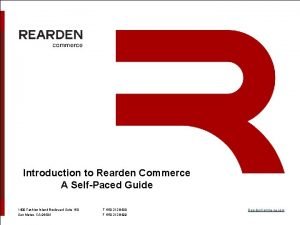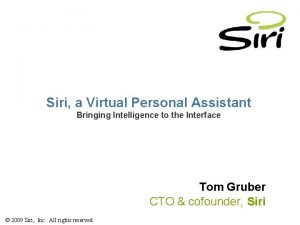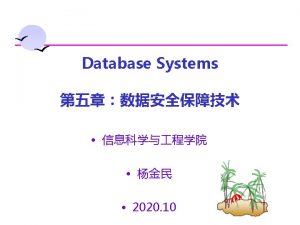User Modeling for Personal Assistant Introduction User Modeling



























- Slides: 27

User Modeling for Personal Assistant

• • Introduction User Modeling Experiment Conclusion

such personal assistants to address the problems • Contextual assistance: if a user is in a city away from home, the assistant might show a personalized list of nearby restaurants and their reviews, without the user ever typing a query. • Interest updates: Personal assistants save users the trouble of finding new information by automatically alerting the user to any new piece of information about their favorite topics. • Fully personalized: when suggesting restaurants, in addition to the spatio-temporal context, the assistant personalizes the suggestions based on the user's cuisine preferencesand price sensitivity.

Personal assistants • personal assistants (or discovery engines) complement traditional search engines • reduce the need to use search engines on a smart phone

Personal assistants • Tasks span multiple sessions have a beginning and an end eg. planning a wedding, may span weeks or months. • Interests span months or years do not have an end eg. sports teams, celebrities, or TV shows. • Habits actions, users take on a regular basis. reading a favorite blog or news site, checking stock prices, or checking traffic in the daily commute.

Taba • user modeling system hundreds of millions of users updates the user model within 10 minutes of a new user action

Taba • content recommendation system collaborative filtering over contexts and users predicts how interested the user will be in recommendations for the context

• • Introduction User Modeling Experiment Conclusion

User Modeling • Input: a sequence of observations from a single user observations: a query together with its associated web results and clicks eg. Video watch, URL visited in browser

User Modeling • Output: a set of contexts context: a sequence of observations that constitutes a single information need.

Classification • similarity function: decide whether the two contexts should be merged into a single context. • return a score that reflects the degree of similarity between the contexts.

Classification Similarity(C 1, C 2)= W 0 +∑i=1~n Wi Vi (C 1, C 2) ⁻ C 1, C 2 two contexts ⁻ Wi is the weight of the ith feature dimension ⁻ Vi(C 1, C 2) ϵ [-1, 1] is the score (value of the similarity metric) of the ith feature dimension for the contexts C 1 and C 2 ⁻ W 0 serves as an (optional) offset ⁻ two contexts to be similar if their similarity score is greater than zero

Feature Dimensions • Cosine used when the feature dimension is a weighted vector of features

Feature Dimensions • Scaled. Cosine takes into account missing features, or low confidence in inferred features. e. g. , some queries or clicks may not map to any entities

Feature Dimensions • Scaled. Cosine – c be the cosine similarity – s 1 (s 2) be the sum of the weights of the features in the first (second) context – m 1 (m 2) be the maximum possible value of s 1 (s 2) – t is neutral point

Feature Dimensions • Max. Fraction computes for each context the fraction of observations that satisfy some property e. g. , matching an observation in the other context takes the maximum of these two fractions as the similarity

Feature Dimensions • Norm. Intersection defined for a pair of sets A, B

Feature Dimensions

Predictive Value Feature Weighting (PVFW) • to weight features by inverse document frequency or inverse query frequency.

Predictive Value Feature Weighting (PVFW) ⁻ ⁻ Oi, Oj be a random pair of observations for a random user U is the set of users u is a user in U Pf(u) is the set of all pairs of observations that have the feature f ⁻ Pfc(u) is the set of all pairs of observations that both have the feature f and are in the same context at the end of segmentation.

Segmentation

content recommendation system • Collaborative filtering -- Interest Updates concept: – Fresh Aggregates – Context Relevance Score – Recommendation Ranking

• • Introduction User Modeling Experiment Conclusion

Experiment

Experiment

• • Introduction User Modeling Experiment Conclusion

Conclusion • hundreds of millions of users, as part of Google Now. • Finally, we presented a new segmentation algorithm, NLAC, that uses indexing and lightweight scoring to provide similar precision and recall to HAC while being 30 times faster
 Rearden commerce
Rearden commerce Siri dahl personal assistant
Siri dahl personal assistant How to email a professor
How to email a professor Cisco personal communications assistant
Cisco personal communications assistant Helen erickson nursing theory
Helen erickson nursing theory Relational vs dimensional data modeling
Relational vs dimensional data modeling User intent modeling
User intent modeling Single user and multiple user operating system
Single user and multiple user operating system Multi user operating system
Multi user operating system Kontinuitetshantering
Kontinuitetshantering Typiska novell drag
Typiska novell drag Nationell inriktning för artificiell intelligens
Nationell inriktning för artificiell intelligens Returpilarna
Returpilarna Varför kallas perioden 1918-1939 för mellankrigstiden?
Varför kallas perioden 1918-1939 för mellankrigstiden? En lathund för arbete med kontinuitetshantering
En lathund för arbete med kontinuitetshantering Personalliggare bygg undantag
Personalliggare bygg undantag Personlig tidbok för yrkesförare
Personlig tidbok för yrkesförare A gastrica
A gastrica Förklara densitet för barn
Förklara densitet för barn Datorkunskap för nybörjare
Datorkunskap för nybörjare Stig kerman
Stig kerman Att skriva debattartikel
Att skriva debattartikel För och nackdelar med firo
För och nackdelar med firo Nyckelkompetenser för livslångt lärande
Nyckelkompetenser för livslångt lärande Påbyggnader för flakfordon
Påbyggnader för flakfordon Vätsketryck formel
Vätsketryck formel Svenskt ramverk för digital samverkan
Svenskt ramverk för digital samverkan Lyckans minut erik lindorm analys
Lyckans minut erik lindorm analys


















































